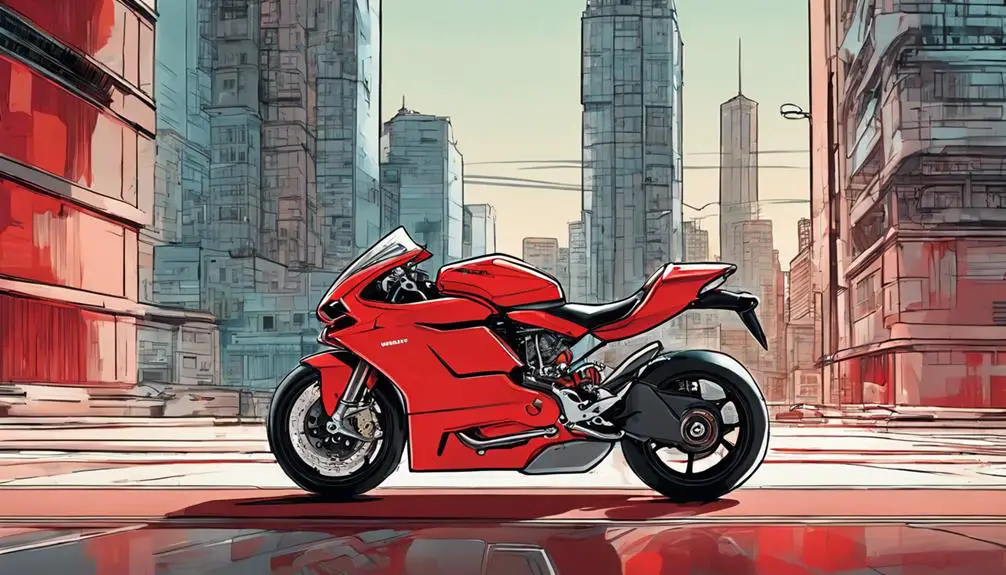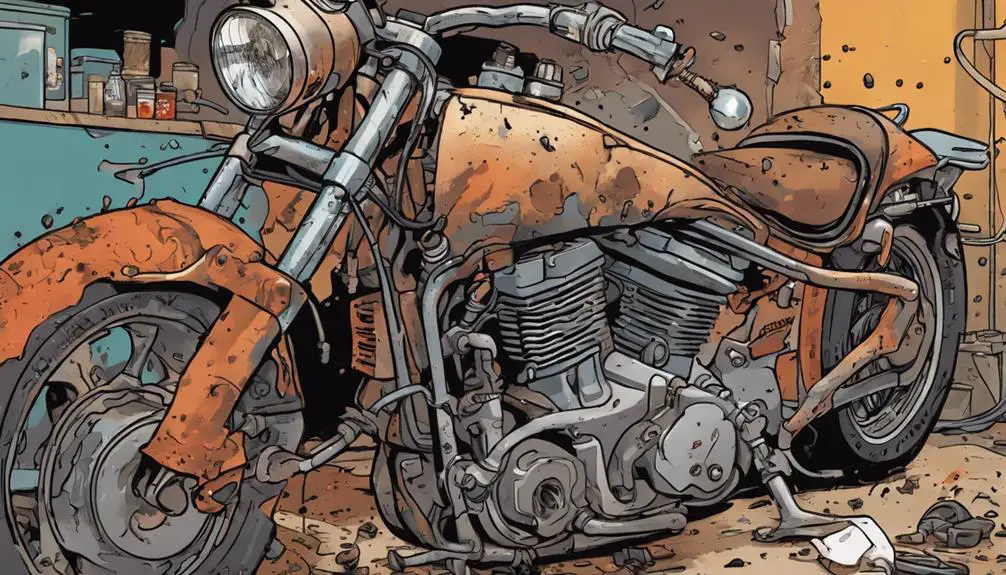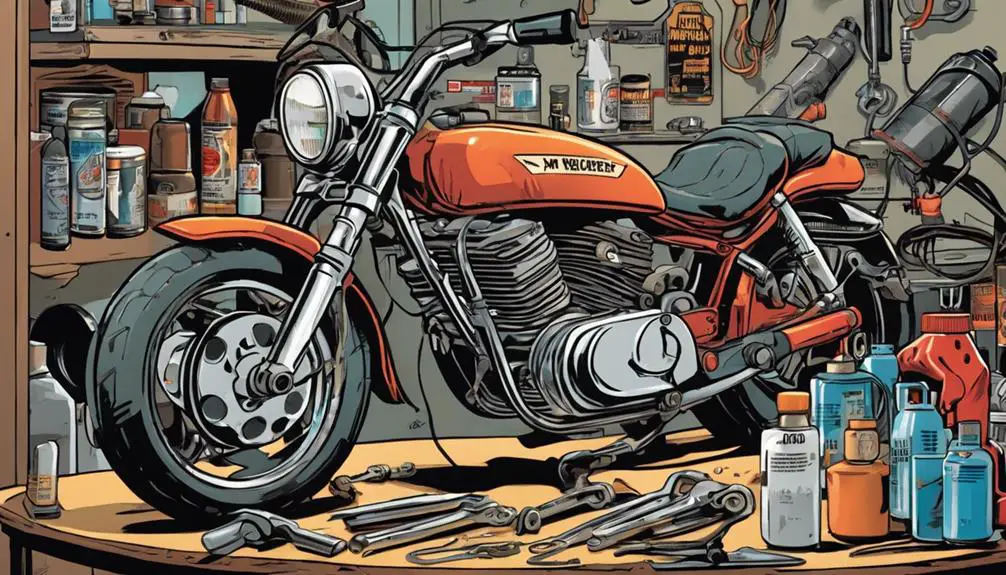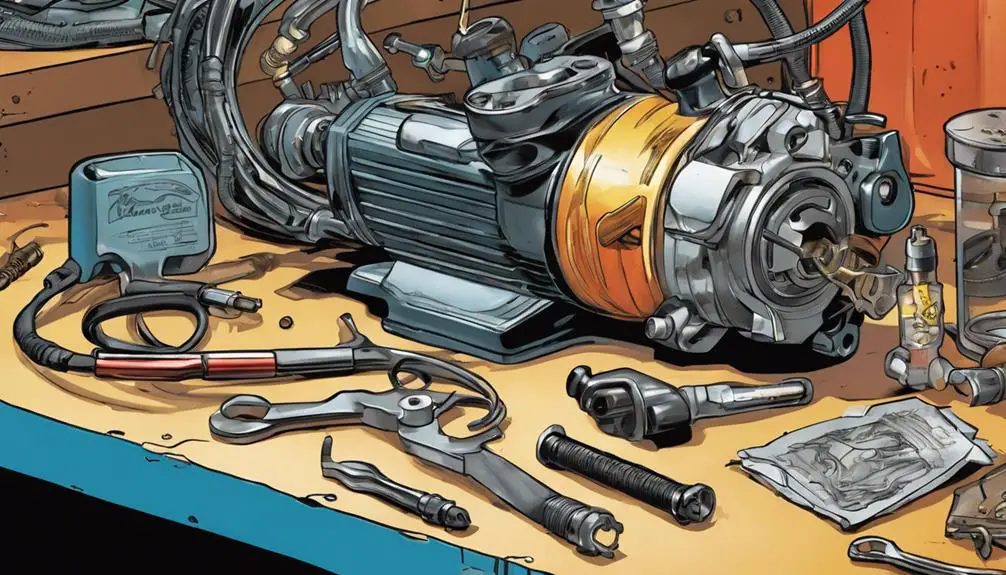You might be surprised to learn that fuel pump failures are among the most common issues faced by Ducati motorcycle owners. These failures can arise from various factors, including contaminated fuel and electrical system malfunctions, which can leave you stranded at the worst possible moment. Understanding the underlying causes can help you avoid unexpected repairs and guarantee your bike runs smoothly. So, what exactly leads to these costly fuel pump failures, and how can you prevent them from happening to your ride?
Key Takeaways
- Contaminated fuel from dirty tanks or poor-quality gas can clog filters and strain the fuel pump, leading to failure.
- Electrical issues, such as faulty wiring or weak batteries, disrupt power flow essential for fuel pump operation.
- Overheating from clogged filters or low fuel levels can significantly reduce the lifespan of fuel pumps.
- Unusual engine noises, decreased fuel efficiency, and starting difficulties often signal impending fuel pump issues.
Overview of Ducati Motorcycles

Ducati motorcycles are renowned for their exceptional performance and distinctive Italian design, making them a favorite among riders. When you hop on a Ducati, you feel an exhilarating connection to the road, as if the bike is an extension of your own spirit. Each model combines cutting-edge technology with a rich racing heritage, delivering not just speed, but also an engaging riding experience that releases your sense of adventure.
From the agile Monster to the powerful Panigale, Ducati offers a diverse lineup to satisfy your urge for freedom on two wheels. You'll notice the meticulous craftsmanship in every detail, from the sleek lines to the throaty roar of the engine. This isn't just a motorcycle; it's a statement of individuality and passion.
Riding a Ducati is about more than just getting from point A to B; it's about embracing the journey, the wind in your hair, and the thrill of the ride. Whether you're cruising through city streets or carving up mountain roads, a Ducati invites you to break free from the ordinary and experience the extraordinary.
Fuel Pump Functionality
Understanding how fuel pumps work is fundamental for any motorcycle enthusiast, especially when it comes to maintaining the high performance that brands like Ducati are known for. Fuel pumps are the unsung heroes of your bike's engine, delivering the right amount of fuel to the combustion chamber. When you twist the throttle, the pump springs into action, guaranteeing your machine has the fuel it needs to release its power.
These pumps typically operate using either a mechanical or electric system. Mechanical pumps rely on engine pressure, while electric pumps draw power from your battery, pushing fuel to the injectors. The pressure and flow rate are significant; they must match the engine's demands to guarantee peak performance. If the pump malfunctions, you might experience sluggish acceleration or stalling, robbing you of the freedom that comes with riding.
Regular maintenance checks, including inspecting fuel lines and filters, can help keep your fuel pump functioning effectively. By understanding this essential component, you empower yourself to keep your motorcycle running smoothly, allowing you to fully embrace the exhilarating experience of the open road.
Your ride deserves it, and so do you!
Common Causes of Failures

When it comes to fuel pump failures, understanding the common causes can save you a lot of trouble.
Contaminated fuel, electrical system problems, and overheating due to wear are key issues you should watch out for.
Contaminated Fuel Issues
Contaminated fuel can lead to serious fuel pump failures, often stemming from issues like dirty storage tanks or improper handling during refueling. When you fill up your motorcycle, you expect clean, high-quality fuel, but that isn't always the case. If the fuel's tainted with dirt, water, or other contaminants, it can clog the fuel filter and strain the pump, causing it to work harder than it should.
You mightn't realize it, but using fuel from questionable sources can set you up for failure. Even the finest machines can succumb to the effects of poor fuel quality. Over time, those contaminants can corrode internal components of the pump, leading to breakdowns and costly repairs.
Taking a proactive approach is your best defense. Always choose reputable gas stations, and consider using fuel additives designed to clean your system and protect against contamination. Regularly inspect your fuel lines and filters, too.
Electrical System Problems
Electrical system problems can sneak up on you, often leading to frustrating fuel pump failures if not addressed promptly. Your motorcycle's electrical system is essential for ensuring the fuel pump operates efficiently.
Here are some common issues you might encounter:
- Faulty wiring: Damaged or corroded wires can interrupt power flow, leaving your fuel pump in the dark.
- Weak battery: A battery that can't hold a charge may fail to provide the necessary power for your fuel pump's operation.
- Bad relays: If the fuel pump relay malfunctions, it can prevent the pump from receiving power when you need it most.
Overheating and Wear
Overheating and wear can greatly reduce your fuel pump's lifespan, leading to unexpected failures on the road. When you push your motorcycle to its limits, the fuel pump works harder. If it runs too hot, the internal components can suffer from excessive friction, leading to premature wear. This wear can compromise the pump's efficiency, causing it to struggle to move fuel at the necessary pressure.
One common cause of overheating is a clogged fuel filter. If debris builds up, it forces the pump to work harder, generating extra heat. You might also encounter problems if the pump isn't submerged in fuel; it relies on the surrounding fuel for cooling. Running low on fuel can expose the pump to air, causing it to overheat.
To free yourself from these pesky issues, regularly check your fuel system. Inspect filters, keep your tank filled, and listen for any unusual noises from the pump. By staying vigilant, you'll guarantee your fuel pump operates smoothly, allowing you to enjoy the freedom of the open road without fear of failure.
Take control of your bike's health, and ride with confidence!
Signs of Fuel Pump Issues
If you notice unusual engine noises while riding, it might be a sign of fuel pump issues.
Additionally, decreased fuel efficiency and starting difficulties can indicate that your pump isn't functioning properly.
Staying alert to these symptoms can help you address problems before they escalate.
Unusual Engine Noises
Unusual engine noises can signal potential fuel pump issues, making it essential for riders to pay attention to any changes in sound while operating their motorcycles. If you hear something off, it could indicate that your bike's fuel pump isn't functioning as it should. Trust your instincts and investigate further.
Listen for these common sounds:
- Whining or buzzing: A high-pitched noise may signal a failing fuel pump struggling to deliver fuel.
- Rattling or clunking: Unusual metallic sounds can indicate internal damage within the pump.
- Intermittent sputtering: If your engine stutters or hesitates, the fuel pump might be losing its ability to maintain pressure.
Being aware of these noises can empower you to act before bigger issues arise, ensuring you maintain your freedom on the open road.
Listen closely, trust your ride, and don't ignore the whispers of your machine. Taking action now can help you avoid being stranded later.
Decreased Fuel Efficiency
Noticing a drop in fuel efficiency can be a red flag that your motorcycle's fuel pump isn't working properly. When you find yourself stopping at the pump more often, it's time to pay attention. A faulty fuel pump can lead to inadequate fuel delivery, causing your engine to struggle and consume more fuel than necessary.
You might feel that sense of freedom slipping away as you watch your fuel gauge drop faster than it should. This isn't just about the money you're spending; it's about the joy of the ride. A well-functioning fuel pump keeps your motorcycle performing at its best, allowing you to explore the open road without constant worry.
If you're experiencing poor fuel efficiency, take action. Check for signs of a failing fuel pump, like fluctuating power or lagging acceleration. You deserve a motorcycle that delivers the exhilarating performance you crave.
Don't let a malfunctioning fuel pump hold you back from embracing the ride. By addressing these issues early, you can reclaim the freedom of the road and get back to enjoying every twist and turn.
Starting Difficulties
Starting your motorcycle can become a frustrating challenge when the fuel pump begins to fail, leaving you stranded and enthusiastic to hit the road. You might notice some warning signs that indicate your fuel pump's on the brink of collapse. Recognizing these signs is essential to reclaiming your freedom on two wheels.
- Long cranking times: If it takes longer than usual to start, your fuel pump may be struggling to deliver fuel.
- Engine sputtering: If your engine hesitates or stutters, it could signal insufficient fuel pressure.
- Inconsistent performance: Sudden drops in power while riding can indicate an unreliable fuel flow.
These symptoms can disrupt your adventures, but addressing them early can keep your motorcycle in prime condition.
You deserve a ride that's smooth and invigorating, so don't let fuel pump issues hold you back. Stay vigilant, and you'll enjoy the open road with confidence and freedom.
Preventative Maintenance Tips

To keep your motorcycle's fuel pump in top condition, regularly inspect the fuel system for leaks and confirm the fuel filter is clean. A dirty filter can restrict fuel flow, putting extra stress on your pump.
Every few months, check the fuel lines for cracks or wear. Replace any damaged components immediately to prevent bigger problems down the road.
Make it a habit to change your fuel filter according to the manufacturer's recommendations. This simple step can make a world of difference.
Also, consider adding a fuel stabilizer if you're parking your bike for an extended period. This helps prevent fuel degradation, which can lead to pump failure.
Don't forget about the electrical connections! Make certain all wiring is secure and free from corrosion. A loose connection can disrupt the pump's function, leading to costly repairs.
Lastly, keep an eye on your bike's overall performance. If you notice a decrease in power or unusual noises from the fuel pump, address these issues promptly.
Impact of Fuel Quality
Fuel quality plays a significant role in the performance and longevity of your motorcycle's fuel pump, impacting everything from fuel flow to engine efficiency. When you choose low-quality fuel, you're putting your ride at risk. Poor fuel can lead to deposits and blockages that hinder your pump's operation, making it work harder and wear out faster.
Here are a few key points to evaluate:
- Contaminants: Water and dirt in fuel can damage your pump and injectors.
- Octane Ratings: Using the wrong octane can affect combustion efficiency and lead to engine knocking.
- Additives: Some fuels contain additives that can either benefit or harm your system. Know what you're putting in.
Repair Vs. Replacement Options

When faced with a failing fuel pump, you'll need to weigh the options between repairing the existing unit or replacing it entirely. Repairing can be a tempting choice, especially if the damage seems minimal. You might save some cash and can often get back on the road shortly.
However, it's vital to take into account the long-term implications of a repair. If the pump's components are wearing out, a repair might only serve as a temporary fix, leaving you stranded again down the line.
On the other hand, replacing the fuel pump gives you peace of mind. While it usually costs more upfront, a new unit can provide better reliability and performance. You'll also free yourself from worrying about repeated failures, allowing you to ride with confidence.
Ultimately, think about your riding habits and budget. If your bike's your freedom machine, investing in a replacement might just be the ticket to liberation. It's about more than just the cost; it's about your experience on the road.
Choose the option that aligns with your vision of freedom, ensuring you're ready for every adventure ahead.
Expert Recommendations and Solutions
Choosing the right solution for a failing fuel pump often calls for expert advice to guarantee you make an informed decision. You don't want to find yourself stranded or dealing with more issues down the road. Here are some key recommendations to evaluate:
Consult with a mechanic: A trusted professional can diagnose the specific problems and suggest tailored solutions.
Evaluate your riding habits: Understanding how you use your motorcycle can help determine if a repair or replacement is best for you.
Explore aftermarket options: Sometimes, aftermarket fuel pumps can provide better performance and reliability than OEM parts.
Stay proactive: Regular maintenance checks can help catch issues before they escalate, freeing you from future hassles.
Frequently Asked Questions
How Long Do Ducati Fuel Pumps Typically Last?
Ducati fuel pumps typically last between 30,000 to 50,000 miles, but several factors can influence their lifespan.
Your riding habits, maintenance practices, and the conditions you ride in all play a role.
If you keep your fuel clean and maintain your motorcycle regularly, you might extend that lifespan.
However, it's essential to stay alert for signs of wear or failure, as that'll help you catch any issues before they escalate.
Can Weather Conditions Affect Fuel Pump Performance?
Did you know that over 50% of fuel pump issues are linked to extreme weather conditions? You could find yourself stuck on the side of the road, feeling frustrated, because your fuel pump's performance dipped in the heat or cold.
Temperature fluctuations can cause fuel to thicken or evaporate, leading to potential failures. Staying aware of these conditions can help you avoid unexpected breakdowns and keep your rides smooth and liberating.
Are Aftermarket Fuel Pumps Reliable for Ducati Motorcycles?
When considering aftermarket fuel pumps for your Ducati, reliability can vary.
Some brands offer quality components that perform well, while others might cut corners, leading to issues.
It's essential to research reviews and seek recommendations from fellow riders.
You want a fuel pump that not only fits your bike but also delivers consistent performance.
Trust your instincts, and don't hesitate to invest in a reputable option to keep your ride smooth and liberating.
Is Fuel Pump Failure More Common in Older Models?
Picture an aging warrior, battle-worn and weary; older motorcycle models often face fuel pump failures more frequently.
As time marches on, wear and tear take their toll, leaving you vulnerable on the road.
You'll find that the fuel pumps in these seasoned bikes struggle to maintain their vigor, just like the warrior who's fought too long.
What Tools Are Needed for Fuel Pump Replacement?
To replace a fuel pump, you'll need a few essential tools.
Grab a socket set, a ratchet, and a torque wrench for the bolts. You'll also need pliers, screwdrivers, and a fuel line disconnect tool to safely remove the lines.
Don't forget safety gear like gloves and goggles!
Having a clean workspace and a container for any spilled fuel will make the process smoother and keep you safe.
Enjoy your empowerment in tackling this task!
Conclusion
Just as a well-tuned engine thrives on clean fuel and care, your Ducati's heart—the fuel pump—needs attention to keep roaring down the road.
Neglecting its needs can lead to a breakdown, like a ship lost at sea without a compass.
By staying vigilant and performing regular maintenance, you'll guarantee your ride remains a steadfast companion on all your journeys, sailing smoothly through the twists and turns of life.
So, cherish your machine, and it'll carry you far.